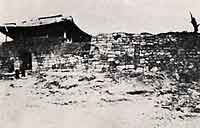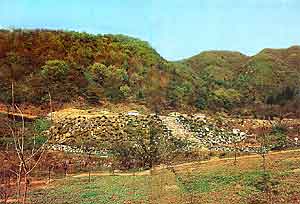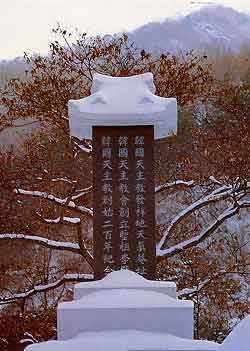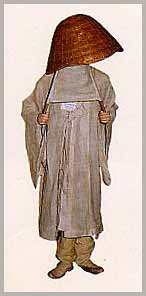

![]()
![]()
|
History of Asian Missions FOR
THE MISSIONS OF ASIA I
- History of the Asian Missions - Introduction of Catholicism
into Korea - Part I It was during the Japanese invasion (1592-1598) that Catholicism had its first direct contact with Korea. A Catholic priest, Gregorio de Cespedes, S. J. and a monk were sent to Korea by a Japanese general as chaplains for the Japanese soldiers stationed in the southern part of Korea. Since it was a war period, they could not have any contact with Korean people. They could only take care of the Japanese soldiers and the Korean prisoners of war, particularly the orphans.
The
gate at Uiju It is noteworthy that Korea began to have contacts with Catholicism through Korean diplomatic envoys, who were regularly sent to China four times a year or on special occasions. The Korean envoys in Peking used to visit Catholic churches and met Jesuit priests frequently. The priests gave some Catholic books to the Korean envoys who brought them back to Korea. Some Korean scholars became so interested in the books that they began to study the new religion. They organized a group to study the new religion in Ch’onjin-am and Chuo-sa. In the study group, Neo-Confucianism, which was the traditional Confucian philosophy in Korea, was compared with the Catholic philosophy. As a result the scholars came to understand and appreciate the new religion. This was how the Catholic faith began to develop in Korea.
Mount
Ch'onjin and Ch'onjinam Valley the birthplace
of the Catholic Church in Korea Finally in 1784, a new era of Catholicism began in Korea. There was a noble scholar called Yi Byok, who read many Catholic books and knew a great deal about the Catholic religion. Through the Korean envoys he tried to get in touch with the foreign priests in Peking in order to obtain more Catholic books. Yi Sung-hun, one of his friends, went with his father to Peking.
The
bicentennial monument of the Catholic Church in Korea (1779-1979, Yi Sung-hun (1756-1801) was a noble scholar of Nam-in Pro-King Party. He read many Catholic books brought in from Peking. He is the one, who while he was in Peking, was baptized with the name of Peter. He returned to Korea to found the Catholic lay church community for the first time in the history of the nation, thus becoming a Peter of the Orient. He was a son of Yi Tong-uk and was born in Seoul in 1756. His father passed the national examination and was a high ranking government official. His mother was a great grand daughter of Yi Ik, a Neo-Confucian Pragmatism scholar, and a sister of Yi Ka-hwan, a well known writer of the day. Yi Sung-un was very intelligent and was able to read the difficult Chinese literature at a very young age. He became well known among the scholars at the age of 20. He married a sister of Tasan Chong Yak-yong, who was famous for summarizing Neo-Confucian Pragmatism. With his brothers-in-law he read the Catholic books brought in from Peking. He tried to imitate the virtues of the saints and to associate with the noble scholars of the day, at the same time promoting the Catholic faith among his friends. In the winter of 1783, his father, Yi Tong-uk, was assigned to go to Peking as a chancellor of the envoys group. Yi Byok and others of the Catholic study group urged Yi Sung-hun to accompany his father. They arrived in Peking in December of that year. For 40 days of his stay in Peking, Yi Sung-hun frequently visited the North Catholic Church and asked the western priests there to baptize him. Father Louis de Grammont, a French ex-Jesuit missionary, after having asked him questions in writing, decided that he was well qualified for baptism. He baptized Yi Sung-hun in February of 1784 and gave him the name of Peter. When he returned he became the first to organize a Catholic faith community in Korea. This incident marks the beginning of the Catholic Church, made up entirely of lay people in Korea. Peter returned to Seoul with many Catholic books, crosses, rosaries, statues, etc. and gave them to Yi Byok. He also baptized his associates. Yi Byok whom Peter baptized and gave the name of John the Baptist, taught and baptized Kwon Ch’ol-shin and his brother Kwon Il-shin, Chong Yak-jong, Chong Yak-jon, Chong Yak-yong (three brothers), Kim Bom-u and many others. Since the number of believers had increased, Yi Byok made the house of Kim Bom-u in Seoul (the present site of Myongdong Cathedral) a sort of church, and held Sunday celebrations there. Thus the Catholic Church, made up of lay people only, was founded in Korea. Korea is the only country in the world throughout the centuries, where the Catholic Church was founded, not by foreign missionaries, but spontaneously by the native people themselves. The Catholic Church is very proud of this fact. The Catholic in those days called one another "believing friends", abolished class distinctions, stopped offering sacrifices to their ancestors and spread the faith, using books written in the Korean alphabet which is different from the Chinese characters. The Catholic community, which had been so miraculously founded, was detected by the government officials in March of 1785, and the Catholics were dispersed. Kim Bom-u, who had allowed his house be used as a sort of church, was arrested, suffered severe tortures and died two years later in exile. This was the first persecution suffered by the early Catholics. Two years later, Yi Sung-hun organized a Catholic group anew. Kwon Il-shin, Yi Sung-hun, Yi Tan-won, Yu-Hang-gom and Ch’oe Ch’ang-hyon made themselves priests. They offered Sunday Masses and administered sacraments. However, they soon realized that this was a mistake and stopped practicing it. They sent Yun Yu-il to Peking in 1789 to consult the bishop of Peking for necessary guidance. The missionaries in Peking advised him to make efforts to introduce priests into Korea. Kwon Il-shin and his associates kept asking the bishop of Peking (Gouvéa) to send priests to Korea. The bishop of Peking finally assigned a Chinese priest, O (Jean dos Remedios), to go to Korea. But he failed to enter Korea because he missed the guide who was supposed to lead him to Korea. The reason for a new persecution was the fact that Yun Chi-ch’ung Paul, a man of the nobility, refused to offer a sacrifice to his deceased mother. As he was noble man and a government official, he was supposed to offer such a sacrifice. Other noble people, who were displeased with this incident, sent repeated reports to the king, denouncing the Catholic religion as a heresy. The king finally ordered Yun Chi-ch’ung to be sentenced to death on December 7, 1791.
Ancient
mourning dress of Korea. Later in 1794, a Chinese priest, Chu Mun-mo Vellozo, was assigned for Korea. He was successful in entering Korea on December 23, 1794. However, he became an occasion for another persecution, because the central government tortured many Catholics in order to locate him. Ch’o In-gil Matthew and a few others were killed during this persecution. Ho-Nau, August 16, 1836 (...) There are in China approximately 40 European priests and 80 Chinese priests. This is a minute number of labourers, even for the actual number of Christians. In many provinces, there are occasional conversions among pagans, but in the midst of such an enormous population, it barely makes a perceptible difference. One day a young pagan was admitted in a room where I was seated. He sat right in front of me and examined me with such minute care as to seem to want to draw my portrait. Then he left, fully satisfied, did he say, to have seen... a European nose! It has been his heart’s desire to contemplate at least once in his life this marvel because he had heard his father, who had seen our venerable Fr. Clet, say that a European man had a longer nose than a Chinese. The mention of Fr. Clet reminds me to tell you the joy I have to be able to work in this part of the Lord’s vineyard which Fr. Clet cultivated with such zeal and success. But can you not send us a whole squadron of St. Francis Xaviers for our China who needs it so badly? May God increase our number, sanctify us and fill us with his spirit. The conversion of China depends also on the prayers said by Christians of Europe (- and of the whole world - Ed.) for this country. "Pray for one another that you may be saved; the prayer of the just, done with fervour, has a great power." (James V, 16) If you see prayers rising to heaven from all side increasing, intensifying, then, all of you from afar, are in a better position than we who are here, to judge if the kingdom of God is near for this powerful nations. What a consolation it would be for the Church to see entering the fold a whole people so remarkable, so attractive such as the Chinese people! Now, if all children would join their hands and storm the Father of Mercies, soon or late they would obtain this great miracle in spite of the obstacles which seem to render this impossible. The members of the Association for the Propagation of the Faith took this noble mission on themselves. Please God, all those who are brothers in Jesus Christ will be enkindled with such a zeal for the interests of Our Divine King, will enroll themselves in the same spiritual campaign and take the weapons of prayer to pursue this warfare which will bring the ruin of Satan’s empire. Saint
Jean-Gabriel Perboyre, P.M. (Reference: Correspondance, St. J.G. Perboyre, C.M., Rome, 1996, Letter 77, extracts.)
|



